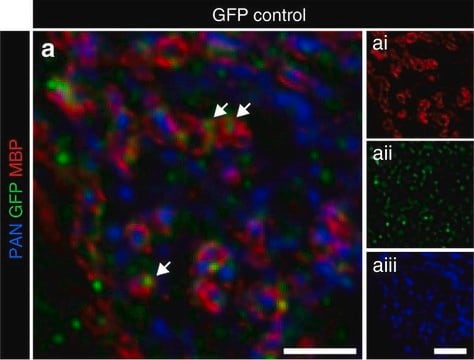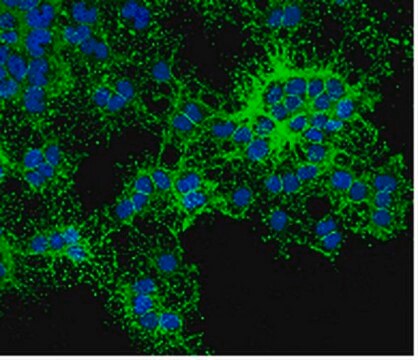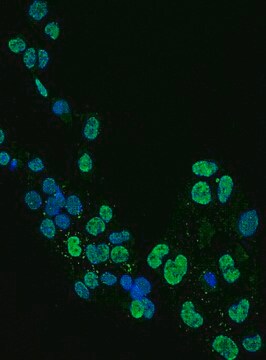MAB345M
Anti-O4 Antibody, clone 81
clone 81 (mAB O4), Chemicon®, from mouse
Synonyme(s) :
Sulfatide
About This Item
Produits recommandés
Source biologique
mouse
Niveau de qualité
100
300
Forme d'anticorps
purified immunoglobulin
Type de produit anticorps
primary antibodies
Clone
81 (mAB O4), monoclonal
Espèces réactives
rat, mouse, human, chicken
Fabricant/nom de marque
Chemicon®
Technique(s)
immunocytochemistry: suitable
immunohistochemistry: suitable
Isotype
IgM
Adéquation
not suitable for Western blot
not suitable for immunoprecipitation
Conditions d'expédition
wet ice
Modification post-traductionnelle de la cible
unmodified
Spécificité
Application
Immunocytochemistry: 10-20 μg/mL on cells fixed with 4% paraformaldehyde.
Note: O4 is a sulfatide, which can be dissolved out of the membrane by organic solvents; acetone and methanol should not be used for fixation.
Optimal working dilutions must be determined by the end user.
Immunohistochemistry protocol
1. Prepare sections from unfixed, shock frozen tissue. The sections should be 4-5 μm thick. Place the sections on microscope slides.
2. Wash the slide three times for 5 min. each in PBS at room temperature.
3. Block the non-specific binding sites by incubating the sections in a humid chamber with 5% FCS at room temperature for 30 minutes.
4. Wash the slides as described in step 2.
5. Cover the sections with a sufficient amount of MAB345 (10-20 μg/mL in PBS) and incubate in a humid chamber at 37°C for one hour.
6. Wash the slides briefly three times with PBS. Carefully dry around the area to be stained.
7. Cover the sections with a sufficient amount of anti-mouse IgM-fluorescein* solution and incubate in a humid chamber at 37°C for one hour.
8. Wash the slides as described in step 6.
9. Cover the sections with a suitable embedding medium, cover with a cover slip, and examine by fluorescence microscopy.
*HRP or ABC can also be used.
Optimal results can be obtained by titrating the primary and secondary antibodies
Immunocytochemistry
1. Fix the preparations with 4% paraformaldehyde (in PBS) at room temperature for 10 minutes. O4 is a sulfatide which can be dissolved out of the membrane by organic solvents; acetone and methanol should not be used for fixation.
2. Wash the slide three times for 5 min. each in PBS at room temperature.
3. Block the non-specific binding sites by incubating the sections in a human chamber with 5% FCS at room temperature for 30 minutes.
4. Wash the slides as described in step 2.
5. Cover the sections with a sufficient amount of MAB345 (10-20 μg/mL in PBS) and incubate in a humid chamber at 37°C for one hour.
6. Wash the slides briefly three times with PBS. Carefully dry around the area to be stained.
7. Cover the sections with a sufficient amount of anti-mouse IgM-fluorescein solution and incubate in a humid chamber at 37°C for one hour.
8. Wash the slides as described in step 6.
9. Cover the sections with a suitable embedding medium, cover with a cover slip, and examine by fluorescence microscopy.
Note: Do not allow the preparations to dry out during staining.
Forme physique
Remarque sur l'analyse
Rat cortical stem cells or day 3 cell cultures of brains from mouse embryos
Autres remarques
Informations légales
Vous ne trouvez pas le bon produit ?
Essayez notre Outil de sélection de produits.
Code de la classe de stockage
10 - Combustible liquids
Classe de danger pour l'eau (WGK)
WGK 2
Certificats d'analyse (COA)
Recherchez un Certificats d'analyse (COA) en saisissant le numéro de lot du produit. Les numéros de lot figurent sur l'étiquette du produit après les mots "Lot" ou "Batch".
Déjà en possession de ce produit ?
Retrouvez la documentation relative aux produits que vous avez récemment achetés dans la Bibliothèque de documents.
Notre équipe de scientifiques dispose d'une expérience dans tous les secteurs de la recherche, notamment en sciences de la vie, science des matériaux, synthèse chimique, chromatographie, analyse et dans de nombreux autres domaines..
Contacter notre Service technique








